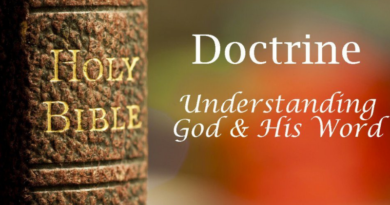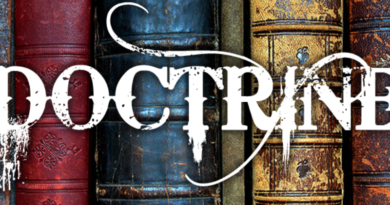BIBLE DOCTRINE 9: THE LORD’S SUPPER
God’s Word teaches:
That the Lord’s supper was instituted by Jesus Christ so that all believers (all members of the family of God) might partake thereof regularly, to “shew the Lord’s death until He come.” The emblems used are “unleavened bread” and the juice of “fruit of the vine.” Anyone who eats and drinks unworthily brings “damnation,” punishment and chastisement upon himself – Matthew 26:29; Luke 22:17-20; 1 Corinthians 11:23-30.
In setting the worship service in the tabernacle, Moses was enjoined to do according to the pattern revealed unto him by God (Exodus 25:9,20; 26:30; Numbers 8:4). This is a command we ought to obey as we consider the doctrine and practice of The Lord’s Supper.
The institution of the Lord’s Supper is clearly shown in the gospels (Matthew 26:17-30; Luke 22:1,7-20). Paul amplified the doctrine in 1 Corinthians 11:20-30. In the gospel according to Saint Luke, we see the links between the Feast of Passover or Unleavened Bread and the Lord’s Supper (Luke 22:15-20). The Lord’s Supper in the New Testament is a type of the Feast of the Passover or Unleavened Bread in the Old Testament (Exodus 12:1-28,40-51). This implies that just as the vicarious death of the Lord Jesus Christ replaced the Sacrifice of the Aaronic or Levitical Priesthood for atonement of sin, so for us
Christians the Lord’s Supper has replaced the Feast of the Passover, as an ordinance. Some churches refer to the Lord’s Supper as the “SACRAMENT”: Latin-sacramentum, meaning Holy Ordinance (1 Corinthians 11:2). The Theologians call it the “EUCHARIST” (Greek – GIVING OF THANKS); still others name it “THE LORD’S TABLE” or the “HOLY COMMUNION” (1 Corinthians 10:16). Those who participate in eating of the Lord’s Supper are called the “Communicants.” The universal name is the Lord’s Supper as used by our Lord.
In spite of the fact that the Lord’s Supper has replaced the Feast of the Passover, if we apply the LAW OF FIRST MENTION as a means of studying the doctrine at hand, vital lessons and inspiration can be drawn from critically looking at the pattern of the celebration of the Feast of Passover in Exodus 12:1-51; Deuteronomy 16:1-8 and 2 Chronicles 30:1-27.
This can be accomplished if we ask ourselves and answer the following questions: When and why was the Passover instituted? (ii) Who was qualified to partake in the ordinance? (iii) What were the tokens or emblems employed in the service? (iv) Who officiated in the service and how did they prepare for the ordinance i.e. place, provision, cost and personal sacrifices? (v) What was the spiritual impact and how often was it done? Parallel questions and answers apply to the Lord’s Supper.
The PASSOVER (Hebrews ‘Pesah’) means, “to pass over” i.e. “to spare” (Exodus 12:13,27). The Israelites were in bondage in Egypt (Exodus 2:11). They cried unto the Lord for deliverance (Exodus3:7-10). Pharaoh did not set them free until God sent vicious plagues upon Egypt. The Passover ordinance was instituted the night when the destroyer killed all the firstborn in Egypt but “passed over” or spared the Jews because of the blood on the lintel and side posts of their doors (a type of Calvary’s
cross). The Feast of unleavened Bread was co-joined with that of the Passover. The two then became known as “The Passover” (Deuteronomy 16:1-8). Sanctified elders and the priests handled the emblems (the blood of pure lamb and unleavened bread). The lamb was to be roasted and not eaten raw. No bone of the lamb was broken (Exodus 12:46; John 1:29; 19:36). This typifies Christ. The defiled, uncircumcised strangers and Gentiles did not participate (Exodus 12:43-49).
However, a qualified person would be cut off from among the Israelites if he refused to eat the Passover (Numbers 9:13). The Jews who did not observe it in the first month because they were not levitically pure, a second chance of eating the Passover was offered in the second month, if they were clean (Deuteronomy 16:1-8; 2 Chronicles 30:1-27).
The preparations made in terms of personal and corporate cleansing, provision of the emblems and the place for the ordinance was elaborate and thorough. History tells us that in the New Testament, a candle light search was made to root out any trace of leaven (impurity) from the location of the Passover. The HALLEL, Psalm 113 to 118 was sung (Matthew 26:30) and the story of Exodus 12:1-14 recounted, bringing to remembrance the deliverance from Egypt. Prayers were also offered. It was a holy convocation. For the Jews, the dates for the Passover now became the beginning of months. It is to be observed forever as a memorial. It brought joy and renewed strength to God’s people (2 Chronicles 30:25,26; 31:1-19).
However, by the deeds of the law no man shall be justified. By the time of Christ, the Passover activities had been commercialised (John 2:13-17). Jesus Christ instituted the Lord’s Supper at the last Passover, for the New Testament believers, thus signifying the end of the latter (Luke 22:1-20). Our Lord Jesus Christ is our Paschal Lamb or Passover (1 Corinthians 5:7). He has delivered us from all bondages, sin, sickness, and Satan. In 1 Corinthians 11:27-32, no unbeliever, fornicator, polygamist, or drunkard could join in the breaking of bread. The syncretic and the occultic did not have part in it. Some became unworthy because of fighting, keeping malice, divisive, and having unforgiving spirit. Any restitution should be settled before the hour of the ordinance (Matthew 5:23,24).
The Lord’s Supper is not the common love feast or marriage reception food (1 Corinthians 11:20-22). We DISCERN the Lord’s Body (1 Corinthians 11:29). This implies we recognize that the emblems, “the fruit of the vine” and the “Unleavened Bread” REPRESENT or SYMBOLISE the Lord’s broken body and His blood that was shed respectively. They are not the actual body and blood of Jesus Christ. This calls for holiness of life and solemnity on our part as we come to the Lord’s table. We take the emblems to SHEW FORTH the Lord’s death. We call to remembrance His love and passion on Calvary’s Cross. The Lord’s Supper is to be taken as practicable, doing it in remembrance of our Lord, till He comes (Matthew 26:17-30; Luke 22:7-13; 1 Corinthians 11:26). We look forward to the Rapture and the Marriage Supper of the Lamb (Revelation 19:7-9). Adequate preparations should be made by the leadership of the church to secure the emblems and a location for the ordinance. More importantly we must keep our total being worthy of it.
In a Bible-believing church, grave consequences can befall those who eat it unworthily. Weakness, sickness or even death could ensue (1 Corinthians 11:30). If you always feel disqualified it is not certain that you will be qualified for the Rapture and the Marriage Supper of the Lamb (Revelation 19:7-18). Adults, youth, and children who have current testimony of salvation and holy living can partake of it.
1. Admit that you are a sinner. "For all [humans] have sinned, and comes short of the glory of God....[and] the wages of sin is death; but the gift of God is eternal life through Jesus Christ our Lord" (Romans 3:23)
2. Repent now. "Repent ye therefore, and be converted, that your sins may be blotted out ...[for] if we confess our sins, he is faithful and just to forgive us our sins, and to cleanse us from all unrighteousness " (Acts 3:19, 1 John 1:9)
3. Believe that God loves you and Jesus died for you. "God commendeth his love toward us, in that, while we were yet Sinners, Christ died for us" (Romans 5:8)
4. Invite Jesus into your life through prayer of faith. Jesus says, "Behold, I stand at the door, and knock: if any man hear my voice, and open the door, I will come in to him, and will sup with him, and he with me" (Revelation 3:20)


